In-Depth
Running a Free Thin-Client OS on a Sub-$100 Mini-PC
Tom's mini-PC can surf/stream, comes up short with office apps and doesn't do Windows 11, but is perfectly capable of running a thin-client OS in a VDI setup.
In two previous articles I talked about how I purchased the cheapest Windows PC I could find, an ATOPNUC MA90, and assessed its quality and usability for home and office use.
I was surprised that I could purchase a Windows 10 computer for less than $100 with 8GB RAM and a 128 SSD drive to stream YouTube videos and browse the internet. However, its PCMark 10 score indicated it was only moderately capable of running home and office applications. Because the processor in the device does not support Windows 11, it has a limited lifespan.
Although it was marginally usable as a Windows PC, I thought it might be a suitable platform to serve as a virtual desktop infrastructure (VDI) client. In this article I will look at 10ZiG's recently announced free thin-client OS, RepurpOS, and see how well it runs on this device.
A Free Thin-Client OS
Earlier this year, 10ZiG announced that RepurpOS would be available for free. 10ZiG claims that FREE means FREE, with no limit on how many devices a company can use and no time limit on how long they will run. This is not a stripped-down version with limited capabilities, but basically the same version the company has preinstalled on the devices it sells. Not only is the OS free, but the management console is free as well.
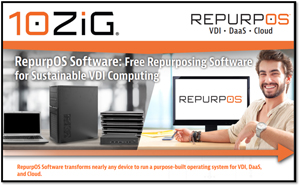 [Click on image for larger view.]
[Click on image for larger view.]
10ZiG states that RepurpOS allows you to repurpose existing PCs to extend the life of PCs that are no longer needed and/or cannot run the latest version of Windows. This will enable companies to reduce costs and reuse devices to mitigate their e-waste. Or, in my case, use a very cheap PC to run it on.
The requirements of the OS are minimal as it supports most x86 processors, only requires 2GB of RAM and 4GB of storage, and supports wired or wireless ethernet. It can be installed and run on a device drive or run directly from a USB drive.
It supports streaming applications and virtual desktops from all the major players, including VMware, Citrix, Microsoft, HP, Frame and Amazon WorkSpaces.
A Sub-$100 Mini-PC
The ATOPNUC MA90 is a mini-PC I purchased on Amazon for $89. It has an AMD A9 9400 CPU (up to 3.2Ghz), 8GB RAM, 128GB SSD, an M.2 and SATA cable connector, support for 4K Dual HDMI, 2.4/5G Wi-Fi, BT5.0 and a 1GbE NIC. It came with off-brand RAM and SSD. Running Windows 10 worked marginally well for streaming videos from YouTube and running a single application. Even if this is all you need it for, its lack of support for Windows 11 gives it a relatively short lifespan.
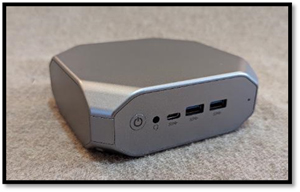 [Click on image for larger view.]
[Click on image for larger view.]
 [Click on image for larger view.]
[Click on image for larger view.]
However, it may work as a thin client. As thin-client OSes connect to virtual desktops or streamed applications, they do not require the same resources as a Windows PC.
When using inexpensive hardware, component failure is one of the issues that needs to be considered. However, this is not a problem with VDI because all the data created is not stored on the physical device but on the cloud or in the datacenter where the virtual desktop is hosted. Therefore, if a component or the entire device fails, it can be easily replaced without losing user data or information. Additionally, thin clients have such low hardware requirements that if the RAM or SSD on this device fails, it can be replaced for less than $20. The processor is from a reliable brand, so it's unlikely to be subject to failure.
Download and Installation
I downloaded RepurpOS after filling out a short form asking just a few basic questions. A short time later, I received an email with a link to download the OS, the license for the OS and a user's guide.
Following the guide, I created a USB drive with the ISO image (RPOS-64_16.5.36) on it.
As I wanted to keep my Windows 10 image, I replaced its stock M2. SATA SSD drive with a Kingston 128 GB SATA SSD drive and installed RepurpOS on it.
After booting the PC from the USB drive, I was greeted with a 10ZiG splash screen and asked which drive I wanted to install RepurpOS.
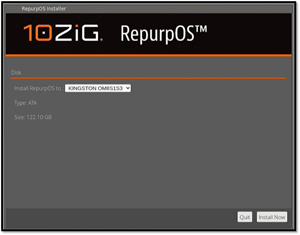 [Click on image for larger view.]
[Click on image for larger view.]
After installing the OS and rebooting the system, I was presented with a splash screen telling me I needed to register the device.
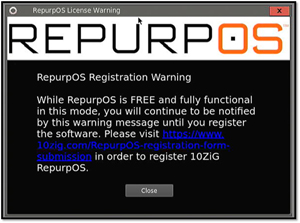 [Click on image for larger view.]
[Click on image for larger view.]
After I entered my registration code, the product was marked as registered.
Installing Third-Party Applications
10ZiG supports plugins and third-party products but currently requires the 10ZiG Manager Server, which runs on Windows and is free, to install them. I Installed and used Manager Server to do this, but its installation and usage are beyond the scope of this article.
I work for ControlUp and installed Remote DX (to monitor the connection to my virtual desktop) and Edge DX (to monitor the device itself) on the device.
The device appeared in my Edge DX tenant seconds after I installed and configured it. I used it to monitor the device's performance while running my tests.
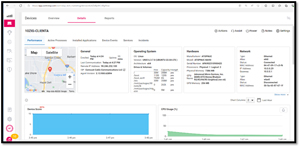 [Click on image for larger view.]
[Click on image for larger view.]
Connecting to a Horizon Desktop
I used a cloud-based Horizon virtual desktop to understand how well the device worked as a thin client. The device was connected to the network via a Cat 6 cable via a 1Gb network through a switch connected to the internet.
The virtual desktop I used ran Windows 10 and had two vCPUs, 8GB of memory and 128GB of NVMe-based storage.
I brought up the Horizon client and configured it to connect to the Horizon desktop at the monitor's native 2K resolution.
I brought up Microsoft Office applications (Word, PowerPoint and Excel) in the Horizon virtual desktop and could run multiple applications simultaneously without difficulty.
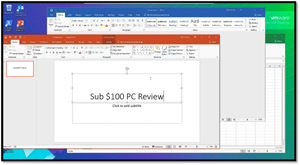 [Click on image for larger view.]
[Click on image for larger view.]
Streaming Videos
To get an idea of how well it could display a video, I streamed a YouTube video with its quality set to auto and then at 1440p. The video played without pausing when set to auto, and the quality was what I would expect. The video quality was excellent when I ran it at 1440p, but it did occasionally buffer.
 [Click on image for larger view.]
[Click on image for larger view.]
When streaming the videos on the virtual desktop and displaying them on the thin client, the CPU usage on the thin client never exceeded 40 percent, and the CPU queue length never exceeded one.
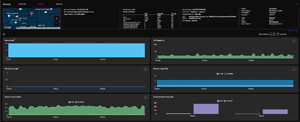 [Click on image for larger view.]
[Click on image for larger view.]
When streaming the same videos on the device while running Windows 10, the CPU usage was 100 percent, and the CPU queue Length occasionally exceeded 20 when the video was streaming at 1440p.
Final Thoughts
Over these three articles, I examined a sub $100 PC and looked at the device's build quality in the first article and performed an initial boot-up. In the second article, I used it for some everyday tasks using Windows as the OS. In the third article, I repurposed the device and installed an enterprise-grade, free, thin-client OS on it from 10ZiG.
A decade ago, I would have been thrilled to find that I could purchase a dual-core PC with 8GB of RAM and a 128GB SSD for under $100. But times have changed, and Windows and the applications that run on it have become more resource-intensive. In my testing, I found that this device would only be suitable for the most menial tasks. Furthermore, the device's lifespan is minimal as the end of support for Windows 10 is October 14, 2025, and Windows 11 is not supported and cannot be installed on it. As such, I cannot recommend buying this device to run Windows.
However, I took the opportunity to install and run RepurpOS, 10ZiG's new free thin-client OS on it. I found that it was perfectly capable for this use case. Even when streaming videos and running Windows applications on my Horizon virtual desktop, it only used a fraction of the resources available on the device. I also found that the thin client OS was, in fact, totally and completely free, installed, and ran on the device without any problems.
I am glad I finally had the opportunity to work with RepurpOS, as it has been something I have been excited about and meaning to work with since it was first announced. It was 100 percent free, easy to install and performed flawlessly on this inexpensive device. I only used it to connect to a Horizon desktop. Still, it also supports Citrix, Desktop-as-a-Service (DaaS) offerings from Microsoft (AVD and Windows 365), AWS (WorkSpaces) and other virtual desktops and streaming applications.